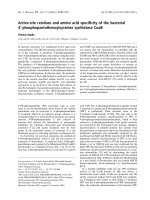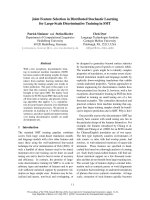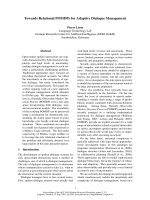Báo cáo khoa học: "Active Sample Selection for Named Entity Transliteration" pptx
Bạn đang xem bản rút gọn của tài liệu. Xem và tải ngay bản đầy đủ của tài liệu tại đây (560.54 KB, 4 trang )
Proceedings of ACL-08: HLT, Short Papers (Companion Volume), pages 53–56,
Columbus, Ohio, USA, June 2008.
c
2008 Association for Computational Linguistics
Active Sample Selection for Named Entity Transliteration
Dan Goldwasser Dan Roth
Department of Computer Science
University of Illinois
Urbana, IL 61801
{goldwas1,danr}@uiuc.edu
Abstract
This paper introduces a new method for
identifying named-entity (NE) transliterations
within bilingual corpora. Current state-of-the-
art approaches usually require annotated data
and relevant linguistic knowledge which may
not be available for all languages. We show
how to effectively train an accurate transliter-
ation classifier using very little data, obtained
automatically. To perform this task, we intro-
duce a new active sampling paradigm for guid-
ing and adapting the sample selection process.
We also investigate how to improve the clas-
sifier by identifying repeated patterns in the
training data. We evaluated our approach us-
ing English, Russian and Hebrew corpora.
1 Introduction
This paper presents a new approach for constructing
a discriminative transliteration model.
Our approach is fully automated and requires little
knowledge of the source and target languages.
Named entity (NE) transliteration is the process of
transcribing a NE from a source language to a target
language based on phonetic similarity between the
entities. Figure 1 provides examples of NE translit-
erations in English Russian and Hebrew.
Identifying transliteration pairs is an important
component in many linguistic applications such as
machine translation and information retrieval, which
require identifying out-of-vocabulary words.
In our settings, we have access to source language
NE and the ability to label the data upon request.
We introduce a new active sampling paradigm that
Figure 1: NE in English, Russian and Hebrew.
aims to guide the learner toward informative sam-
ples, allowing learning from a small number of rep-
resentative examples. After the data is obtained it is
analyzed to identify repeating patterns which can be
used to focus the training process of the model.
Previous works usually take a generative approach,
(Knight and Graehl, 1997). Other approaches ex-
ploit similarities in aligned bilingual corpora; for ex-
ample, (Tao et al., 2006) combine two unsupervised
methods. (Klementiev and Roth, 2006) bootstrap
with a classifier used interchangeably with an un-
supervised temporal alignment method. Although
these approaches alleviate the problem of obtain-
ing annotated data, other resources are still required,
such as a large aligned bilingual corpus.
The idea of selectively sampling training samples
has been wildly discussed in machine learning the-
ory (Seung et al., 1992) and has been applied suc-
cessfully to several NLP applications (McCallum
and Nigam, 1998). Unlike other approaches,our ap-
proach is based on minimizing the distance between
the feature distribution of a comprehensive reference
set and the sampled set.
2 Training a Transliteration Model
Our framework works in several stages, as summa-
rized in Algorithm 1. First, a training set consisting
53
of NE transliteration pairs (w
s
, w
t
) is automatically
generated using an active sample selection scheme.
The sample selection process is guided by the Suf-
ficient Spanning Features criterion (SSF) introduced
in section 2.2, to identify informative samples in the
source language.An oracle capable of pairing a NE
in the source language with its counterpart in the tar-
get language is then used. Negative training samples
are generated by reshuffling the terms in these pairs.
Once the training data has been collected, the data
is analyzed to identify repeating patterns in the data
which are used to focus the training process by as-
signing weights to features corresponding to the ob-
served patterns. Finally, a linear model is trained us-
ing a variation of the averaged perceptron (Freund
and Schapire, 1998) algorithm. The remainder of
this section provides details about these stages; the
basic formulation of the transliteration model and
the feature extraction scheme is described in section
2.1, in section 2.2 the selective sampling process is
described and finally section 2.3 explains how learn-
ing is focused by using feature weights.
Input: Bilingual, comparable corpus (S, T ), set of
named entities NE
S
from S, Reference
Corpus R
S
, Transliteration Oracle O,
Training Corpora D=D
S
,D
T
Output: Transliteration model M
Guiding the Sampling Process1
repeat2
select a set C ⊆ NE
S
randomly3
w
s
= argmin
w∈C
distance(R, D
S
∪ {w
s
})4
D = D ∪ {W
s
, O(W
s
)}5
until distance(R,D
S
∪ {W
s
}) ≥ distance(R,D
S
) ;6
Determining Features Activation Strength7
Define W:f → s.t. foreach feature f ={f
s
, f
t
}8
W (f) =
(f
s
,f
t
)
(f
s
)
×
(f
s
,f
t
)
(f
t
)
9
Use D to train M;10
Algorithm 1: Constructing a transliteration
model.
2.1 Transliteration Model
Our transliteration model takes a discriminative ap-
proach; the classifier is presented with a word pair
(w
s
, w
t
) , where w
s
is a named entity and it is
asked to determine whether w
t
is a transliteration
Figure 2: Features extraction process
of the NE in the target language. We use a linear
classifier trained with a regularized perceptron up-
date rule (Grove and Roth, 2001) as implemented
in SNoW, (Roth, 1998). The classifier’s confi-
dence score is used for ranking of positively tagged
transliteration candidates. Our initial feature extrac-
tion scheme follows the one presented in (Klemen-
tiev and Roth, 2006), in which the feature space con-
sists of n-gram pairs from the two languages. Given
a sample, each word is decomposed into a set of sub-
strings of up to a given length (including the empty
string). Features are generated by pairing substrings
from the two sets whose relative positions in the
original words differ by one or less places; first each
word is decomposed into a set of substrings then
substrings from the two sets are coupled to complete
the pair representation. Figure 2 depicts this process.
2.2 Guiding the Sampling Process with SSF
The initial step in our framework is to generate a
training set of transliteration pairs; this is done by
pairing highly informative source language candi-
date NEs with target language counterparts. We de-
veloped a criterion for adding new samples, Suffi-
ciently Spanning Features (SSF), which quantifies
the sampled set ability to span the feature space.
This is done by evaluating the L-1 distance be-
tween the frequency distributions of source language
word fragments in the current sampled set and in
a comprehensive set of source language NEs, serv-
ing as reference. We argue that since the features
used for learning are n-gram features, once these
two distributions are close enough, our examples
space provides a good and concise characterization
of all named entities we will ever need to con-
sider. A special care should be given to choos-
ing an appropriate reference; as a general guide-
line the reference set should be representative of
the testing data. We collected a set R, consisting
54
of 50,000 NE by crawling through Wikipedia’s arti-
cles and using an English NER system available at
- cogcomp. The frequency
distribution was generated over all character level
bi-grams appearing in the text, as bi-grams best cor-
relate with the way features are extracted. Given a
reference text R, the n-grams distribution of R can be
defined as follows -D
R
(ng
i
) =
ng
i
j
ng
j
,where ng
is an n-gram in R. Given a sample set S, we measure
the L
1
distance between the distributions:
distance (R,S) =
ng∈R
| D
R
(ng)−D
S
(ng) | Sam-
ples decreasing the distance between the distribu-
tions were added to the training data. Given a set
C of candidates for annotation, a sample w
s
∈ C
was added to the training set, if -
w
s
= argmin
w∈C
distance(R, D
S
∪ {w
s
}).
A sample set is said to have SSF, if the distance re-
mains constant as more samples are added.
2.2.1 Transliteration Oracle Implementation
The transliteration oracle is essentially a mapping
between the named entities, i.e. given an NE in the
source language it provides the matching NE in the
target language. An automatic oracle was imple-
mented by crawling through Wikipedia topic aligned
document pairs. Given a pair of topic aligned doc-
uments in the two languages, the topic can be iden-
tified either by identifying the top ranking terms or
by simply identifying the title of the documents. By
choosing documents in Wikipedia‘s biography cate-
gory we ensured that the topic of the documents is
person NE.
2.3 Training the transliteration model
The feature extraction scheme we use generates fea-
tures by coupling substrings from the two terms.
Ideally, given a positive sample, it is desirable that
paired substrings would encode phonetically simi-
lar or a distinctive context in which the two scripts
correlate. Given enough positive samples, such fea-
tures will appear with distinctive frequency. Tak-
ing this idea further, these features were recognized
by measuring the co-occurrence frequency of sub-
strings of up to two characters in both languages.
Each feature f=(f
s
, f
t
) composed of two substrings
taken from English and Hebrew words was associ-
ated with weight. W (f) =
(f
s
,f
t
)
(f
s
)
×
(f
s
,f
t
)
(f
t
)
where
Data Set Method Rus Heb
1 SSF 0.68 NA
1 KR’06 0.63 NA
2 SSF 0.71 0.52
Table 1: Results summary. The numbers are the pro-
portion of NE recognized in the target language. Lines 1
and 2 compare the results of SSF directed approach with
the baseline system on the first dataset. Line 3 summa-
rizes the results on the second dataset.
(f
s
, f
t
) is the number of occurrences of that feature
in the positive sample set, and (f
L
) is the number of
occurrences of an individual substring, in any of the
features extracted from positive samples in the train-
ing set. The result of this process is a weight table,
in which, as we empirically tested, the highest rank-
ing weights were assigned to features that preserve
the phonetic correlation between the two languages.
To improve the classifier’s learning rate, the learn-
ing process is focused around these features. Given
a sample, the learner is presented with a real-valued
feature vector instead of a binary vector, in which
each value indicates both that the feature is active
and its activation strength - i.e. the weight assigned
to it.
3 Evaluation
We evaluated our approach in two settings; first, we
compared our system to a baseline system described
in (Klementiev and Roth, 2006). Given a bilingual
corpus with the English NE annotated, the system
had to discover the NE in target language text. We
used the English-Russian news corpus used in the
baseline system. NEs were grouped into equiva-
lence classes, each containing different variations of
the same NE. We randomly sampled 500 documents
from the corpus. Transliteration pairs were mapped
into 97 equivalence classes, identified by an expert.
In a second experiment, different learning parame-
ters such as selective sampling efficiency and feature
weights were checked. 300 English-Russian and
English-Hebrew NE pairs were used; negative sam-
ples were generated by coupling every English NE
with all other target language NEs. Table 1 presents
the key results of these experiments and compared
with the baseline system.
55
Extraction Number Recall Recall
method of Top one Top two
samples
Directed 200 0.68 0.74
Random 200 0.57 0.65
Random 400 0.63 0.71
Table 2: Comparison of correctly identified English-
Russian transliteration pairs in news corpus. The model
trained using selective sampling outperforms models
trained using random sampling, even when trained with
twice the data. The top one and top two results
columns describe the proportion of correctly identified
pairs ranked in the first and top two places, respectively.
3.1 Using SSF directed sampling
Table 2 describes the effect of directed sampling
in the English-Russian news corpora NE discovery
task. Results show that models trained using selec-
tive sampling can outperform models trained with
more than twice the amount of data.
3.2 Training using feature weights
Table 3 describes the effect training the model with
weights.The training set consisted of 150 samples
extracted using SSF directed sampling. Three varia-
tions were tested - training without feature weights,
using the feature weights as the initial network
weights without training and training with weights.
The results clearly show that using weights for train-
ing improve the classifier’s performance for both
Russian and Hebrew. It can also be observed that
in many cases the correct pair was ranked in any of
the top five places.
4 Conclusions and future work
In this paper we presented a new approach for con-
structing a transliteration model automatically and
efficiently by selectively extracting transliteration
samples covering relevant parts of the feature space
and focusing the learning process on these features.
We show that our approach can outperform sys-
tems requiring supervision, manual intervention and
a considerable amount of data. We propose a new
measure for selective sample selection which can be
used independently. We currently investigate apply-
ing it in other domains with potentially larger feature
Learning Russian Hebrew
Train- Feature Top Top Top Top
ing weights one five one five
+ + 0.71 0.89 0.52 0.88
- + 0.63 0.82 0.33 0.59
+ - 0.64 0.79 0.37 0.68
Table 3: The proportion of correctly identified transliter-
ation pairs with/out using weights and training. The top
one and top five results columns describe the proportion
of correctly identified pairs ranked in the first place and
in any of the top five places, respectively. The results
demonstrate that using feature weights improves perfor-
mance for both target languages.
space than used in this work. Another aspect inves-
tigated is using our selective sampling for adapting
the learning process for data originating from dif-
ferent sources; using the a reference set representa-
tive of the testing data, training samples, originating
from a different source , can be biased towards the
testing data.
5 Acknowledgments
Partly supported by NSF grant ITR IIS-0428472 and
DARPA funding under the Bootstrap Learning Pro-
gram.
References
Y. Freund and R. E. Schapire. 1998. Large margin clas-
sification using the perceptron algorithm. In COLT.
A. Grove and D. Roth. 2001. Linear concepts and hidden
variables. ML, 42.
A. Klementiev and D. Roth. 2006. Weakly supervised
named entity transliteration and discovery from multi-
lingual comparable corpora. In ACL.
K. Knight and J. Graehl. 1997. Machine transliteration.
In EACL.
D. K. McCallum and K. Nigam. 1998. Employing EM
in pool-based active learning for text classification. In
ICML.
D. Roth. 1998. Learning to resolve natural language am-
biguities: A unified approach. In AAAI.
H. S. Seung, M. Opper, and H. Sompolinsky. 1992.
Query by committee. In COLT.
T. Tao, S. Yoon, A. Fister, R. Sproat, and C. Zhai. 2006.
Unsupervised named entity transliteration using tem-
poral and phonetic correlation. In EMNLP.
56









